
As the stock market continues to break new records, fears of a correction grow stronger. The latest warning message comes from a mathematical formula developed by the deceased Nobel Prize winning economist, James Tobin.
Tobin was an economist from Yale University and he passed away in 2002. He developed a stock market valuation tool known as the Q ratio. The Q ratio compares the market value of companies with the actual value of its physical holdings.
Bloomberg is now reporting that “equities in the U.S. are valued about 10 percent above the cost of replacing their underlying assets – higher than any time other than the Internet bubble and the 1929 peak.” And we all know what followed those two moments in time.
It does not take an expert to know that this type of exponential growth cannot be sustained, especially when it could very well be a false growth created by the Federal Reserve’s quantitative easing plan (QE). QE has the central bank pumping billions of dollars of new money into circulation in order to boost a struggling economy. Most economists worry that this is the equivalent of putting a band-aid on a bullet wound.
Andrew Smithers, the 77-year-old former head of SG Warburg’s investment division, told Bloomberg that he feels the Q ratio is now more relevant than ever because of QE.
“QE is a very dangerous policy, in my view, because it has pushed asset prices up and high asset prices, we know from history, are very dangerous,” Smithers told Bloomberg. “It is very strongly indicated by reliable measures that we’re looking at a stock market which is something like 80 percent over-priced.”
Not all investors are sold on the Q ratio being a meaningful way to evaluate the market. Most dissenters feel that it is outdated since it was developed as a valuation method for an economy dominated by manufacturing, which is no longer the case. Others are against it because by using the Q ratio investors would have been advised to stay out of the market two years ago and therefore would have missed one of the strongest bull markets in history.
The bottom line, however, is that all good things must come to an end and the warning signs about this current stock market frenzy are becoming too plentiful to ignore. The unpredictable nature of the market is exactly why investors should be highly diversified and why many financial advisors feel that a percentage of your portfolio should be invested in safe-havens like gold. Physical gold is known for increasing in times of economic and global crisis, making it a very popular hedge against a down market.
